-
Posts
1,219 -
Joined
-
Last visited
Content Type
Profiles
Forums
Store
Help Articles
Posts posted by Wolfert
-
-
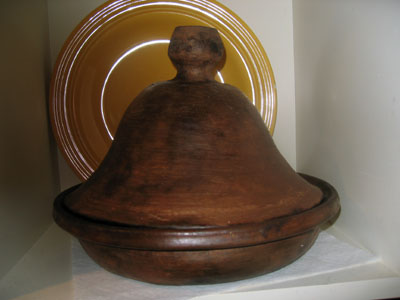
>
>Soak top and bottom of tagine in water to cover for 3 or 4 hours
>Drain and dry.
>Rub top and bottom all over with olive oil
>Rub wood ash (from the fireplace) all over. Hint: wear rubber
gloves
>Bake both parts for 8 hours ina 250 F oven
>let it cool down then wipe away excess dirt..
>Repeat rubbing with olive oil and ash and baking
let dry overnight in an airy place then wash, dry and rub with oil. let relax and add more oil. It loves oil.
Whenever you wash your tagine, wash it with baking soda and water and a plastic scrub brush. Avoid soap Wipe dry and rub with a little oil.
if you have problems arriving at this color after using it a few times, write for help
oh, you can oil the parts of the tagine, place the oven rack far from the broiler and grill certains parts of the tagine here and there for a nice burnished color.
Now what have you done? You've given 'age' to your new tagine. Everyone will think you inherited it from someone's grandmother.
Follow rules above thread for handling hot tagines in a cold environment and other caveats.
-
To keep my publishers from raising their eyebrows, please pm me with your home address and I'll xerox and mail you a copy.
-
One of the most beautiful vegetable dishes of the eastern mediterranean is a vegetable cooked slowly in olive oil under a crumbled sheet of wet parchment. For example, slowly cooked leeks are forced to reabsorb their own moisture as they cook. It is a sort of self basting. A heavy cover is necessary to encourage recycling of moisture.
what other vegetables are done this way? cardoons, celery root, fat green beans and artichokes.
-
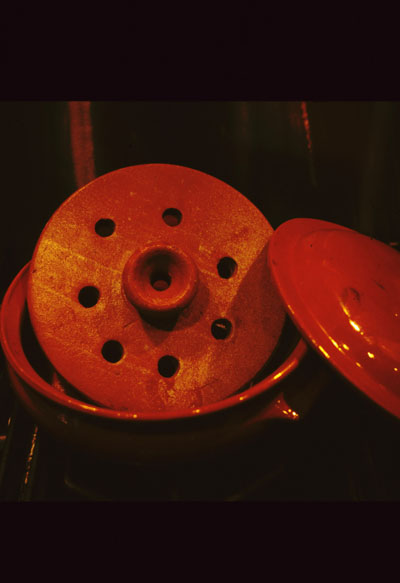
I just had to share this with you all after reading this thread:The Turks actually produce a specific clay platter to hold down stuffed leaves. Not just grape leaves but chard, mulberry, sorrle, fig, cherry, mallow, beet, fava bean and even the stinging nettle. Some of these are so thin and fragile they need something to keep them in place. voila...
-
I use parchment paper over vegetables,fish, poultry and meats when I want to keep in flavor, aroma and moisture. I start off with very little liquid; the paper keeps in all the original moisture, and traps the moisture that develops during the cooking.
The resulting sauce is rich, dense and luscious.
-
I agree. www.tagines.com is the best place I know for Moroccan tagines.
Are you cooking on electricity or gas?
If cooking on electric burners, you will want to purchase the Riffian or the Tangier style with the flat bottom. Be sure to use a heat diffuser.
If cooking over gas, you will want to buy the ourika, marrakech or souss style which is bowl shaped.
Personally, I like the unglazed tagines best. When you decide and purchase one, post which you have chosen and I will post instructions on how to cure and 'age' it so your tagine will produce flavorful stews.
There are some 'don'ts' you need to know: don't put a clay tagine on high heat; don't move a hot tagine onto something cold; don't add cold liquid to a hot tagine; and don't put the cover in the oven. (The cover is a cooling mechanism.) If you want to broil the meat at the end for a luxurious finish do it about 9 inches from the heat source, and don't wash unglazed tagines with soap. Use baking soda and water instead. It works fine.
Keep your unglazed tagines healthy by rubbing them all over with olive oil about once or twice a year.
Here is a picture of a tagine I purchased recently from Sami at www.tagines.com
It is in the Marrakech style.
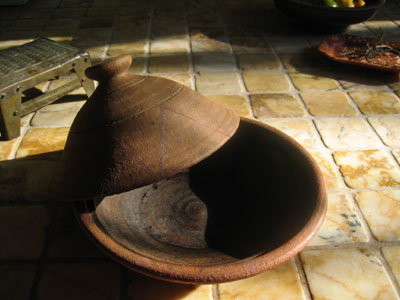
-
Elie:
Your canneles do look beautiful. And, I agree you can't help but love them.
I'm pleased you showed the custardy interiors. They are perfect.
What the bee's wax will bring to the cannele is added crunch and an unusual shine. In fact, in Bordeaux there is one company that makes and delivers the white oil in 5 gallon vats to all of the 87 bakeries. It is very liquidy so you don't need to use very much..
-
To paraphrase President Clinton--- it depends on what the meaning of the word tagine 'is' -
The major characteristic of a Moroccan meat tagine is a highly seasoned (not hot and spicy) sauce, gently reduced to a silken texture through long, slow, steady cooking.
It also means a shallow round pan with a conical top.
Your le creuset will work, but a deep straight-sided large skillet with a tight fitting cover and a sheet of parchment paper placed directly on the food will give you better results.
Most Moroccan tagines have fruits or vegetables added in abundance. In fact, they take over the tagine of meat, chicken or fish and dominate. They aren't usually the "garnish" as in some other cuisines of the Mediterranean, they give the name to the tagine. This is especially true with lamb which fades into the background and enriches the sauce. Chicken and fish play a more prominent role.
Most meat or lamb tagines involve slow simmering of less-expensive cuts. If you see a recipe for leg of lamb to be used in a tagine I would think twice before preparing it. That is if you want to make a Moroccan tagine.
If the meat is to be browned nine times out of ten it will take place at the end of the cooking not the beginning . I could go on, but you need to tell us what kind of tagine you would like to make.
In Algeria, as Chef Zadi can explain much better than I ever could, tagines don't mean the same thing.
And in Tunisia, a tagine is an eggy-enriched meat dish usually baked with a vegetable of some sort. Well, it is more complicated but another time we can talk about Tunisian cooking.
So, welcome to the galaxy of tagines!.Now that is a title of a cookbook that hasn't been written-- as yet! hmmmmm
-
.Go for a shallow heavy bottomed pan and you'll be fine. If you love making Moroccan tagines then you should consider buying one.
l
-
Thanks so much for making all those calls and finding out so much. I will use all the information. And, I'll study some of the Korean recipes via the links to see how they are used . Then I'll have a better grasp of its possibilities in Mediterranean cooking. I know I will use it for Turkish guvec. It even looks like a comlek!
-
Thank you so much for that information. It is going to be great for all the dishes I plan to make for my next book. And, I certainly will use it for confit.
Now, I have to ask some stupid questions: does it go in the dishwasher?
Do I need to cure it? How does it breathe without any unglazed part. Or is the shine just some sort of incredible rubbing with something special to Korea?
Richard: you need to call them up and ask for customer service. They sell the 4 quart earthen bowl with cover for about 24 dollars or so, but they don't have that size on their site.
http://www.koamart.com/shop/48-asian_cookware.asp
$14.99 for the Earthen Bowl with Top - Medium
This turned out to be 6 inches in diameter and would serve one person.
The large size costing about $25 has a capacity of 4 quarts.
-
Thanks for you input.
It is stoneware not earthenware, and incredibly heavy. It is holds about 4 quarts liquid.
I hadn't thought of it as a kimchi pot. I wonder if I could use it to store confit of duck.
-
When you hold a perfect cannele in your hand it should be similar to holding an egg-shaped creme brulee---all crunchy caramelized and almost burnt on the outside and custardy within.
Seth:The interior of your cannele looked ok to me. The custard doesn't overcook at 1 or 1 1/2 or 2 hours, so you can pull them out earlier if you want. With copper and with silicone (see Kit Williams ) the timing I give works perfectly in a calibrated oven. It might be shorter with aluminum...not sure you should reduce the temperature too much unless your calibration is off. You want to sear in the custard.
.
I did notice that Elie's aka foodman's canneles were a tad blacker than mine. I assumed it was due to aluminum versus copper and just let it pass.
In Bordeaux they sell canneles in three shades of darkness. So feel free to experiment to the degree that you like.
Artisanal products like canneles cause problems. That hole in the custard ( even the picture in my book has one) doesn't always happen. More often than not I don't get them. I can't explain why it happens. When I asked I was told that it often happens. SHRUG.
The yellow topping on some of the photos upthread is due to too much fat in the bottom of the mold and the oven not being hot enough to sear the outside right away. Those yellow tops are called 'yelllow rear-ends' in Bordeaux.
Last year, I was told Payards canneles were cake like---more like Nancy Silverton's which are baked for 2 hours at 400 degrees and look beautiful. Nothing wrong with a cakey cannele, but if you prefer the Bordeaux style with the custard interior nothing else will do.
-
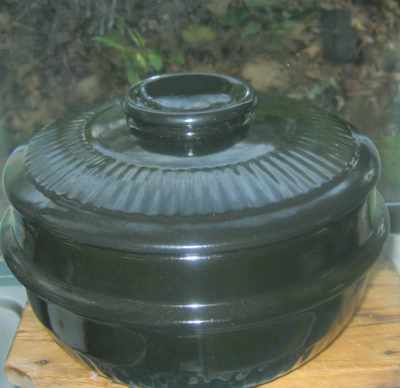
I just purchased this handsome clay pot on the web for about $25.00. Is there anyone out there who could provide information on how it is used in Korean cooking?
What is it called? Are there special regions where it has special uses? Any caveats I need to know before using it? For example, can I use it on top of the stove? One electricity or simply gas? How does it react in the oven? Any temperature restrictions?
Thanks so much
P.s.I found the pot at www.koamart.com.
-
Thank you, Sackville.
You can't do better than traditional Moroccan food done perfectly in a beautiful setting .
-
Daniel, thank you so much for sharing this recipe. I am going to try it asap.
-
Smithy: your pots are beautiful.
I need to re-read the whole thread to refresh my memory but the shallow round one with a good cover probably stood up to the best Staub.
Meantime, check out www.tagines.com for very inexpensive unglazed tagines. The one from Ourika has some mica in it and really holds heat and cooks meat beautifully on top of the stove using a flame tamer if you have electric burners or very low heat over gas.
The one from the Rif is great for cooking a chicken whole among other things. This also should be used on top of the stove. I also bake cakes in the bottom part in the oven.
Here is my recipe for home-curing an unglazed tagine from Morocco:Soak both parts of the tagine in water to cover for 3 or 4 hours; Drain and dry; Rub top and bottom inside and out with olive oil; Put on gloves and rub wood ash (from the fireplace) all over the two parts; and set in a 250 oven and let bake overnight.
Cool down the two parts, wipe away the excess ash, rub again with olive oil and let dry in the oven for an hour or two. Wash and dry the two parts and you are now ready to braise Moroccan style in a tagine on top of the stove.
-
I have a clay pot question right away, for Ms. Wolfert: do they take on the flavors of the foods cooked in them to the point that you reserve some for certain types of food? If so, which do you segregate
I should explain that I only know the cooking of the Mediterranean and the French Southwest and their claypot cooking styles.
In Morocco, fish is almost always cooked in an unglazed pot called a tagra (see photo below). Not because of fear of flavor transfer but the shape is more 'fish-like'
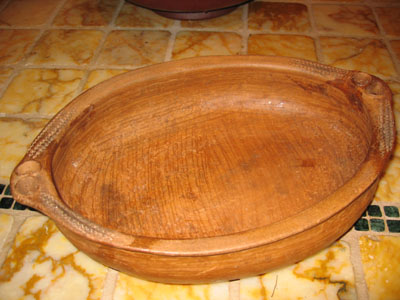
Before I can share what I know about claypot cooking I need to know which pot you were using. So many types of glazes, clays, additions of such minerals as mica, and shapes have a lot to do with the outcome of your braise.
-
Please somehow fit in braising in claypots. I've been braising in claypots for forty-five years and just might be able to offer some commentary from time to time.
-
Take pictures so we have more comparisons to study.
With euro climbing versus the dollar, the tin molds are obviously the way to go.. Also Kim Williams has had wonderful luck with Bridge's silicone molds.
The best time to eat canneles is 2 to 4 hours just out of the oven. Plan ahead.
-
Richard: thank you so much for forwarding that picture. I couldn't find it when I scrolled back earlier this morning.
Elie's canneles look wonderful. I certainly will recommend them from now on.
-
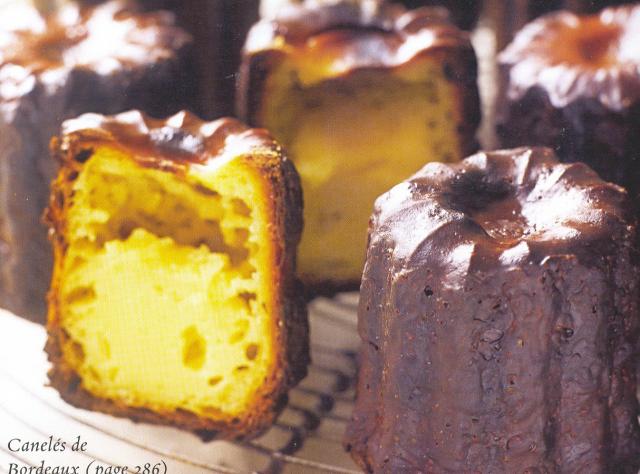
This is the best I can do to zoom in the crunch that I personally love.
-
Seth: don't worry about it. YOur canneles will be fine.
Tin molds don't produce the kind of blackened crunchy crust that I came to love when learning the fine points of the recipe.
A photo showing the super crunch that I like will be posted here in about ten minutes meanwhile iff tin produced crunchy canneles make you happy and put a smile on your face and satisfy your tummy. Stick with them.
Now about egg sizes: the old French way of setting culinary proportions in baking recipes was in "egg weights". This was determined by weighing an egg in shell, then weighing out the flour, sugar, and butter using the weight of the egg as a constant. If you visualize an old fashioned fulcrum type balance scale, the method makes more sense.
-
I haven't a clue of the chemistry behind what I'm seeing, or what it might mean for making a sauce, or what it says about the braising method. Either setup tastes fine, but they're different. Why? Enquiring minds want to know
In the French Southwest, I learned a neat trick to extract from the scum-like bottom layer of solids from your cooled down sauce all its wonderfully intense flavor, and end up with a clear sauce rich enough to coat a spoon lightly.
Here is how to do it: after straining the sauce and pressing down on all the solids with the back of a spoon; cool the entire sauce down; remove all the fat that rises; discard or save for cooking; put the remaining liquid (scum and clear) in a small wide saucepan; and set over heat to bring to a boil. Now, shove the saucepan half off the heat and cook at a slow boil, skimming off all the scum-like solids that rise to the top on the cool side of the liquid for about 10 minutes, or until reduced enough to coat a spoon lightly.
This really works though it might take longer than 10 minutes if you have lots of sauce.



couscous
in Cooking
Posted
Chef Zadi: You have done an absolutely fabulous presentation.
. I'm only sorry I'm too far away to run over and join you all for a late lunch.